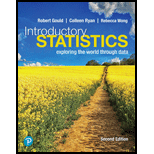
Concept explainers
Pneumonia Vaccine for Young Children A study reported by Griffin et al. compared the rate of pneumonia between 1997 and 1999 before pneumonia vaccine (PCV7) was introduced and between 2007 and 2009 after pneumonia vaccine was introduced. Read the excerpts from the abstract, and answer the question that follows it. (Source: Griffin et al., “U.S. hospitalizations for pneumonia after a decade of pneumococcal vaccination,” New England Journal of Medicine, vol. 369 [July 11, 201]: 155-163)
We estimated annual rates of hospitalization for pneumonia from any cause using the Nationwide Inpatient Sample database. . . . Average annual rates of pneumoniarelated hospitalizations from 1997 through 1999 (before the introduction of PCV7) and from 2007 through 2009 (well after its introduction) were used to estimate annual declines in hospitalizations due to pneumonia.
The annual rate of hospitalization for pneumonia among children younger than 2 years of age declined by 551.1 per 100,000 children . . . which translates to 47,000 fewer hospitalizations annually than expected on the basis of the rates before PCV7 was introduced.
Results for other age groups were similar. Does this show that pneumonia vaccine caused the decrease in pneumonia that occurred? Explain.
Want to see the full answer?
Check out a sample textbook solution
Chapter 1 Solutions
Pearson eText Introductory Statistics: Exploring the World Through Data -- Instant Access (Pearson+)
Additional Math Textbook Solutions
Elementary Statistics: Picturing the World (7th Edition)
Math in Our World
Elementary & Intermediate Algebra
Precalculus
Precalculus: Mathematics for Calculus (Standalone Book)
APPLIED STAT.IN BUS.+ECONOMICS
- A company found that the daily sales revenue of its flagship product follows a normal distribution with a mean of $4500 and a standard deviation of $450. The company defines a "high-sales day" that is, any day with sales exceeding $4800. please provide a step by step on how to get the answers in excel Q: What percentage of days can the company expect to have "high-sales days" or sales greater than $4800? Q: What is the sales revenue threshold for the bottom 10% of days? (please note that 10% refers to the probability/area under bell curve towards the lower tail of bell curve) Provide answers in the yellow cellsarrow_forwardFind the critical value for a left-tailed test using the F distribution with a 0.025, degrees of freedom in the numerator=12, and degrees of freedom in the denominator = 50. A portion of the table of critical values of the F-distribution is provided. Click the icon to view the partial table of critical values of the F-distribution. What is the critical value? (Round to two decimal places as needed.)arrow_forwardA retail store manager claims that the average daily sales of the store are $1,500. You aim to test whether the actual average daily sales differ significantly from this claimed value. You can provide your answer by inserting a text box and the answer must include: Null hypothesis, Alternative hypothesis, Show answer (output table/summary table), and Conclusion based on the P value. Showing the calculation is a must. If calculation is missing,so please provide a step by step on the answers Numerical answers in the yellow cellsarrow_forward
 Big Ideas Math A Bridge To Success Algebra 1: Stu...AlgebraISBN:9781680331141Author:HOUGHTON MIFFLIN HARCOURTPublisher:Houghton Mifflin Harcourt
Big Ideas Math A Bridge To Success Algebra 1: Stu...AlgebraISBN:9781680331141Author:HOUGHTON MIFFLIN HARCOURTPublisher:Houghton Mifflin Harcourt Glencoe Algebra 1, Student Edition, 9780079039897...AlgebraISBN:9780079039897Author:CarterPublisher:McGraw Hill
Glencoe Algebra 1, Student Edition, 9780079039897...AlgebraISBN:9780079039897Author:CarterPublisher:McGraw Hill Functions and Change: A Modeling Approach to Coll...AlgebraISBN:9781337111348Author:Bruce Crauder, Benny Evans, Alan NoellPublisher:Cengage Learning
Functions and Change: A Modeling Approach to Coll...AlgebraISBN:9781337111348Author:Bruce Crauder, Benny Evans, Alan NoellPublisher:Cengage Learning Linear Algebra: A Modern IntroductionAlgebraISBN:9781285463247Author:David PoolePublisher:Cengage Learning
Linear Algebra: A Modern IntroductionAlgebraISBN:9781285463247Author:David PoolePublisher:Cengage Learning




